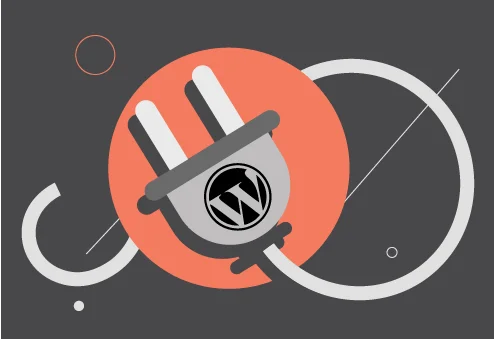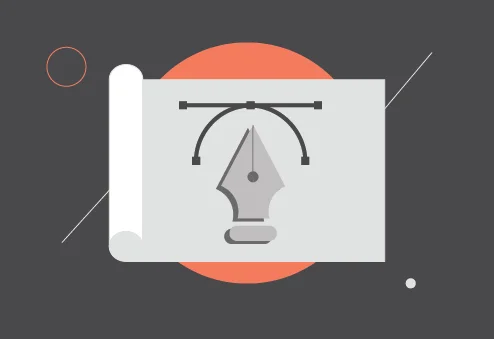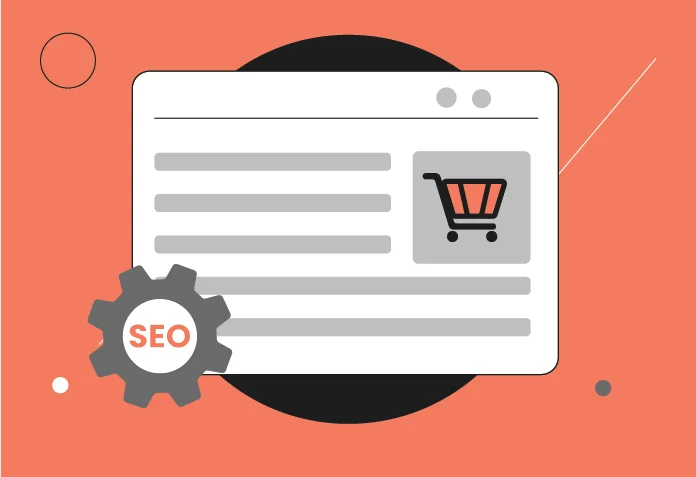Do you ever open your laptop to start writing your article, and don’t know where to start?
You get confused in your flow of thoughts without a clear structure in mind. That’s why it’s easier to find a blog post template that will serve as a guide throughout the writing process and keep your thoughts aligned.
Learn how to choose blog post templates and get access to the most common templates today, and don’t worry about giving a lot of time to structuring your articles.
What is a Blog Post Template?
A blog post template is a ready-to-use structure that helps content writers create blog posts faster.
It contains the title, heading, and subheading structure in the right order to keep users engaged and focused on reading.
Here’s how it helps:
- Simplifies the writing process, so you can focus on creativity instead of outlining
- No need to rewrite blog sections
- Provides an easy-to-follow layout
- Helps overcome writer’s block by giving you a clear starting point
Now, let’s look at some practical blog post templates you can use to speed up the writing process and create well-structured, engaging content every time.
5 Mostly Used Blog Post Templates
Obviously, the same kind of template cannot work for every kind of blog post.
Each type follows a different structure based on reader expectations that will lead to optimal conversions.
Below are the most common blog post templates you can use to get started! Feel free to customize them to fit your writing style.
How-to Blog Posts
How-to posts are made to educate readers on how to do something step by step.
For example, a blog post titled “How to Set Up a Home Office in 5 Easy Steps” can guide readers through choosing a workspace, selecting furniture, organizing cables, setting up lighting, and providing clear instructions at each step.
Now let’s have a look at what your how-to blog post could look like.
H1: How to [Action] [Item] in [Timeframe/Stps]
Ex. How to Achieve Higher Rankings in One Year
Introduction
- Introduce the topic or the task you’ll be teaching.
- Mention why it’s important or who will benefit from it.
- Give a brief overview of what the guide will cover.
H2: Key [Tools/Materials/…] You Need for [item]
Ex. Key Tools You Need for SEO
- List tools, materials, or prerequisites needed to complete the task.
- Include optional alternatives if applicable.
- Briefly explain why each item is necessary.
H2: [Number] Steps to [action] [item]
Ex. 5 Steps to Rank Higher On Google
Give a general description of why these steps are necessary.
H3: Step [number] – [action]
Ex. Step 1: Optimize On-Page Elements
- Describe the step clearly and concisely.
- Give relevant examples.
- Include images, screenshots, or other visuals.
H3: Step [number] [Action]
Ex. Step 2: Build Relevant Backlinks
- Explain the step and why it matters.
- Provide relevant examples.
- Include images, screenshots, or diagrams.
Continue detailed instructions until the task is complete.
H2: Expert [Tips/Strategies/Tactics] For [Task/Goal]
Ex. Expert Tips for SEO Success
- Include additional advice to make the process smoother or faster.
- Share alternatives or hacks that improve results.
H2: [Troubleshooting/Solving/Addressing/…] Common [Problems/Issues] in [Task/Goal]
Ex. Troubleshooting Common Ranking Issues
- List common problems readers may encounter.
- Provide solutions or workarounds for each problem.
H2: Conclusion
- Recap the main points of the how-to guide.
- Emphasize the benefits of completing the task correctly.
- Include a CTA if relevant (e.g., download a checklist, watch a video, try the technique).
Pro tip: Remember that you can always add FAQs or links for further reading to encourage exploring your blog more.
With these tips in mind, your tutorials will keep your readers and actually deliver them the knowledge without any gaps.
Listicle Blog Posts
Listicle blog posts are often the most engaging and easy to follow. This type of content usually includes a list of tools, services, trends, or types of a specific strategy.
For instance, a listicle post could be “10 Best AI Tools to Streamline Your Content Creation Process,” where each item highlights a tool’s features, benefits, and pricing.
Here is a simple listicle blog post template to follow:
H1: [Number] Best [Tools/Strategies/Ideas] for [Goal or Audience]
Ex. 10 Best SEO Tools for Small Businesses
Introduction
- Introduce the topic and explain why it matters.
- Mention the target audience or problem this list will help solve.
- Briefly state what the reader can expect to learn or gain from the list.
H2: How to [Choose/Manage/Use] the Right [Tool/Trend/Idea]
Ex. How to Choose the Right SEO tool
Give a small introduction to H3s
H3: Identify Your [Goal/Objectives] Before Choosing [Tool/Trend/Idea]
Ex. Define Your SEO Goals Before Choosing a Platform
- Explain why this matters
- Describe how one can identify their goals/objectives
H3: Compare [Features/Capabilities] of [Tool/Trend/Idea]
Ex. Compare the Features of various SEO tools
- List some of the key features of different tools
- Compare the features and mention the unique aspects.
H3: Evaluate [Usability/Ease of Use] for [Tool/Trend/Idea]
Ex. Evaluate the SEO Platform Usability
- Explain why this matters
- Describe how to evaluate usability
Add as many H3s as necessary
H2: [Number] Expert [Tools/Platforms/Ideas/Trends] to [Goal/Audience]
Ex. 10 Expert Platforms for SEO Success
Give a small introduction to guide the reader to the next section.
H3: 1. [Item Name]
Ex. Ahrefs
- Brief overview of the platform.
- Highlight what makes it stand out.
- Include cost or availability details.
- Explain how it helps the reader achieve their goal.
H3: 2. [Item Name]
Ex. SEMrush
- Description
- Key Features/Benefits
- Pricing/Accessibility
- Why It Matters
Repeat the same structure for each item in the list
H3: Expert [Tips/Hacks/Advice] for [Strategy/Goal/Task]
Ex. Expert Tips for Your SEO strategy
- Share practical advice for maximizing benefits from the items listed.
- Include trends, best practices, or strategies to follow.
H2: Conclusion
- Summarize the top picks or most important takeaways.
- Reiterate who will benefit most from the list.
- Optional CTA: Encourage readers to try, download, or explore more.
It’s recommended not to overload your conclusion with CTA’s, always keep it natural to the context, and place them where users actually need them.
Here is an example of a natural CTA that can complement your lead generation: “Try out a few of these productivity tools this week and see which ones help streamline your workflow most effectively”.
Product Review Blog Post
Product reviews are helpful articles that guide readers toward deciding whether or not to buy something. It builds trust when done honestly and clearly.
For a credible product review, you must use the tool thoroughly yourself and show its good and bad sides. For instance, an SEO agency can write a review of Ahrefs for SEO reporting, with clear cons and pros, leaving the final choice to the reader.
In this example, you can see a part of a HubSpot review blog post, with the lists of the pros and cons of the product, where a detailed overview of the platform will follow.
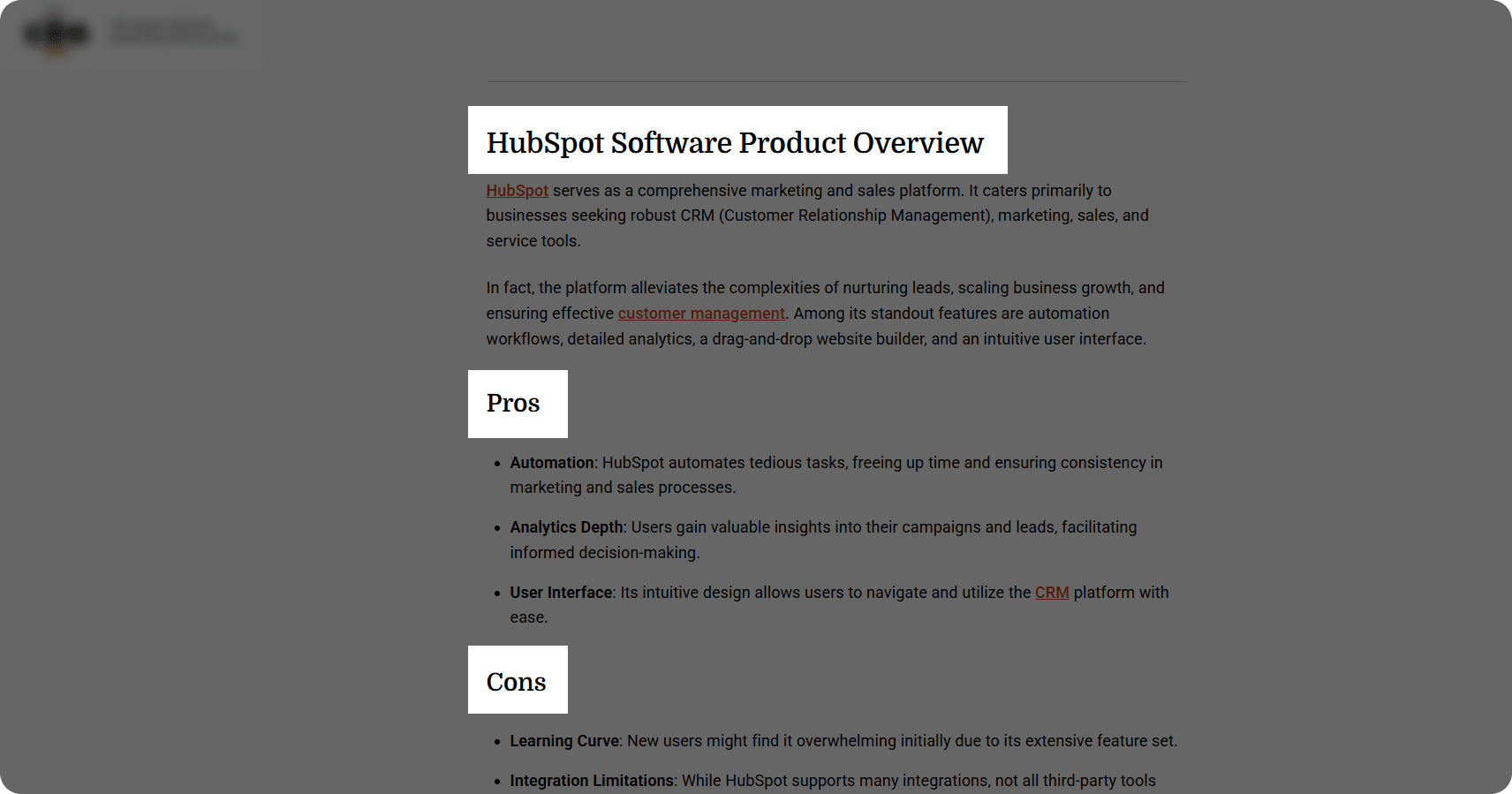
Here is your starting point:
H1: [Product Name] Review: [Key Highlights/Focus]
Ex. SEMrush review: Features, Pricing, and Pros & Cons
Introduction
- Introduce the product and its main purpose.
- Mention the target audience or problem it solves.
H2: Key [Features/Highlights/Functionalities/…] of [Product Name]
Ex. Key Features of SEMrush explained
Give a small introduction to H3s
H3: [Feature 1]
Ex. Keyword Research
- Describe the feature
- Why it matters
- Provide examples/screenshots
H3: [Feature 2]
Ex. Competitor Analysis
- Describe the feature
- Why it matters
- Provide examples/screenshots
Add as many features as necessary.
H2: How [Product Name] Helps [Users/Companies/Individuals/…] Achieve [Goal/Task]
Ex. How SEMeush Helps Users Achieve Backlink Growth
- Describe how well the product performs in real-life scenarios.
- Talk about user interface, usability, and learning curve.
- Optional: Include screenshots or examples
H2: [Pros and Cons/Strengths and Weaknesses/…]: [Product Name 1] vs [Product Name 2]
Ex. Benefits and Weaknesses: Ahrefs VS SEMrush
Give a small introduction to H3s
H3: [Pros/Benefits/Advantages] of [Product Name]
Pros of SEMrush
- Provide bullet points of the positive sides
H3: [Cons/Drawbacks/Weaknesses] of [Product Name]
Cons of SEMrush
- Provide bullet points of the negative sides
H2: [Product] [Pricing/Cost/Subscription Plans]
Ex. SEMrush Pricing
- List different pricing tiers or plans (if applicable).
- Compare with similar products in the market.
- Explain whether it’s worth the cost.
H2: Conclusion
- Summarize key points.
- State who will benefit the most from this product.
- Include a recommendation and optional CTA (e.g., link to purchase).
Make sure to keep it honest and not miss important details, such as pricing and limitations, to keep the readers coming back.
Case Study Blog Post
Case studies show real results from using a product, service, or strategy. This format is ideal for professional services wanting to show their results and is for users wanting proof of credibility before committing to the service.
For example, in an Ahrefs case study, we can see how they significantly increased the website traffic with detailed examples and results.
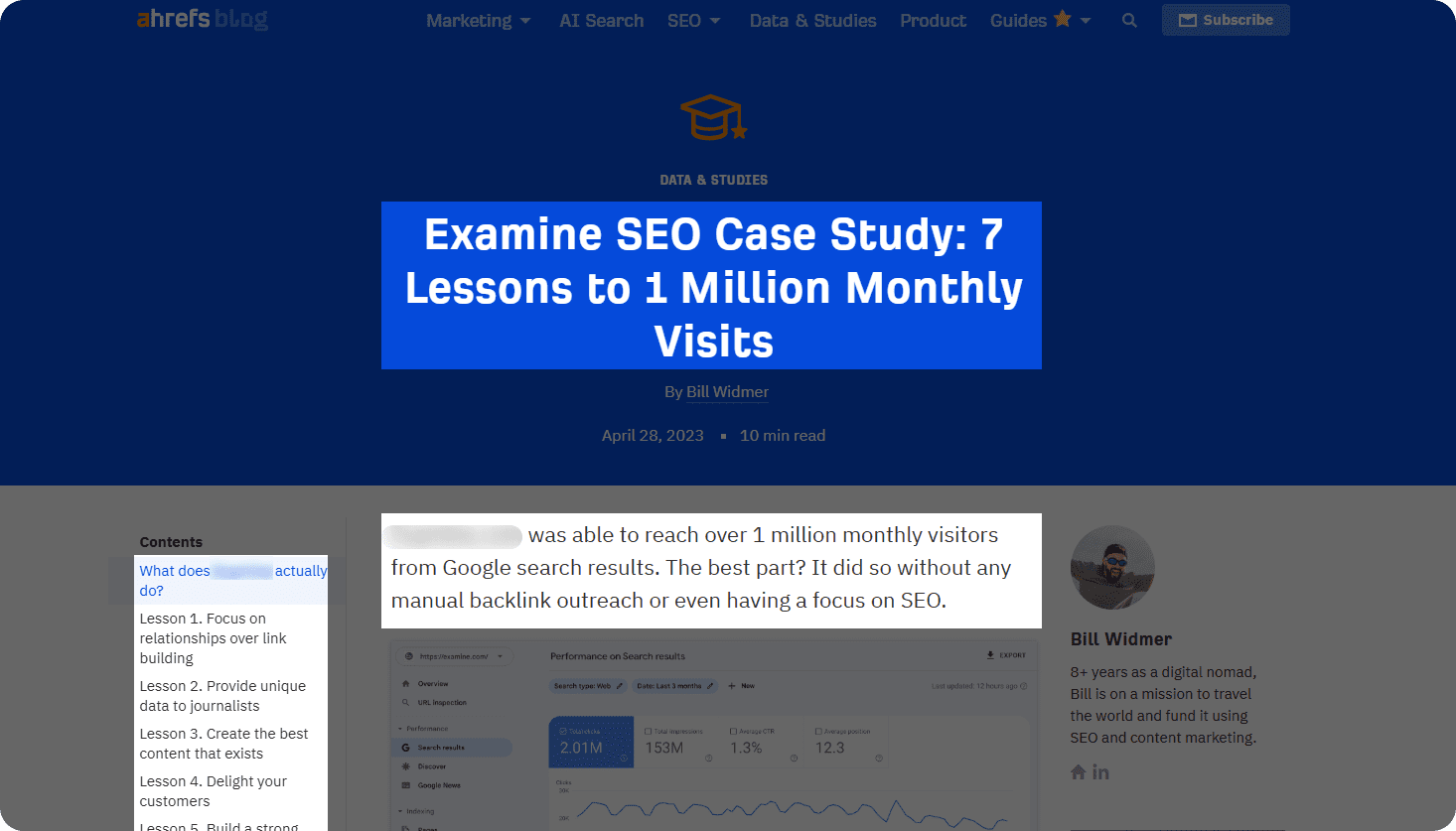
Further reading:
Examine SEO Case Study: 7 Lessons to 1 Million Monthly Visits
H1: How [Company] [Action] [Item] Sales by [Number/Percentage] Using [Product/Service]
Ex. How a Digital Marketing Agency Boosted SaaS Subscriptions by 45% Using HubSpot Marketing Hub
Introduction
- Introduce the client or company briefly.
- Highlight the challenge or goal they aimed to achieve.
- State what the case study will cover (solution, process, results).
H2: [Background/History/Initial Situation] of [Company name]
Ex. Initial Situation of the Agency
- Describe the industry, size, target audience, or relevant context.
- Briefly state the Initial situation/challenge, and describe the problem or pain points.
H2: [Goals/Objectives/Milestones…] of [Company name]
The Main Objectives that the Agency Wanted to Achieve
- Define what the client wanted to achieve.
- Include measurable targets if possible (KPIs, numbers, timelines).
- Outline the plan or methodology.
H3: [Strategy/plan of action] behind [item]
Ex. Strategy behind increasing SaaS subscriptions
- Describe step-by-step actions taken.
- Add screenshots or examples
H2: Results: [Numbers/Percentages] Achieved in [Target/Benchmark/Item/…]
Ex. Results – 45% Increase in SaaS Subscriptions
- Show quantitative results (e.g., increased sales by X%, reduced costs by Y%).
- Show qualitative results (e.g., improved customer satisfaction, streamlined workflows).
- Include charts, screenshots, or quotes if applicable.
H2: Conclusion
- Summarize the success story.
- Emphasize the impact on the client’s business.
- Optional CTA (e.g., contact you for similar solutions).
In case of very specific case studies, collaborate with your other team members for accurate and professional information. At the same time, refine the content to be easily digestible, as your readers will want to read it in an understandable language.
Comparison Blog Post
Comparison posts help decide between two or more options. These work well for product comparison or buyer guides. Here, the important thing is to provide an honest and unbiased opinion.
For example, a post comparing Ahrefs VS SEMrush breaks down features, pricing, integrations, and user experience to help readers choose the best SEO tool for their team.

[Screenshot of comparison blog post title]
H1: [Product/Service 1]vs [Product/Service 2]: Which is Better for [Use case]
Ex. SEMrush vs Ahrefs: Which is Better for Link Building?
Introduction
- Introduce the products/services being compared.
- Explain why a comparison is relevant for the audience.
- State the goal of the post (help readers make an informed choice).
H2: Overview of [Product/Service 1] and [Product/Service 2]
Ex. Overview of Ahrefs and SEMrush
- H3: [Product/Service 1] – Brief description, purpose, and main features.
- H3: [Product/Service 2] – Brief description, purpose, and main features.
H2: [Product/Service 1]vs [Product/Service 2]: Key [Features/Functions/Benefits] Comparison
Ex. Key Features Comparison: Ahrefs VS SEMrush
Write a short introduction to the section.
H3: [Feature 1]
Ex. Backlink Tracking
- Compare how each product handles it.
H3: [Feature 2]
Ex. Website Audit
- Compare how each product handles it.
H3: [Feature 3]
Ex. Technical SEO
- Compare how each product handles it.
Add as many features as necessary.
H3: [Pros/Benefits/Advantages] of [Product Name 1]
Ex. Pros of Ahrefs
- Provide bullet points of the positive sides
H3: [Cons/Drawbacks/Weaknesses] of [Product Name 1]
Ex. Cons of Ahrefs
- Provide bullet points of the negative sides
H3: [Pros/Benefits/Advantages] of [Product Name 2]
Ex. Pros of SEMrush
- Provide bullet points of the positive sides
H3: [Cons/Drawbacks/Weaknesses] of [Product Name 2]
Ex. Cons of SEMrush
- Provide bullet points of the negative sides
H2: [Pricing/Cost/…] Comparison [Product/Service A] VS [Product/Service B]
Ex. Pricing Comparison: Ahrefs vs. SEMrush
- Break down pricing plans, value for money, or hidden costs.
H2: Which One do [Users/Companies/Individuals…] Prefer? [Product/Service A] or [Product/Service B]?
Ex. Which One do SEOs Prefer? Ahrefs or SEMrush
- Compare usability, speed, reliability, or support.
- Include screenshots, tables, or charts if needed.
H2: Final Thoughts
- Summarize which product/service is better for specific use cases or audiences.
- Provide recommendations based on the comparison.
- Optional CTA (e.g., try a demo, buy now, or learn more).
Make sure to test these tools thoroughly before writing any verdicts, as it will impact your credibility later.
Beginner Tips for Writing Blog Posts
If you are new to SEO or just exploring ideas to renew your blog writing strategy, you might need some tips to guide you through the blog writing process. Check them out!
Identify Your Blog’s Goal
Before choosing your blog topic, decide whether the post is meant to inform, entertain readers, or improve the conversion rate. This will help you structure your blog post accordingly and keep your target readers engaged all the way to the CTA.
Here is what to do:
- Decide what you want to achieve with your post
- Match your tone and structure to your goal.
- Create CTAs that align with your intended outcome.
For instance, if your goal is to build brand awareness about the most effective digital marketing strategies, you might write an industry insights piece like “Emerging Marketing Trends to Watch in 2025.”
But if your goal is lead generation, a post such as “Top 5 CRM Tools to Streamline Your Sales Workflow” can attract readers actively searching for the CRM solution you offer and how it stands out in the market.
Write with a reader-first mindset
Always keep your reader in mind. Put yourself in the shoes of the reader and think about what would catch their attention and what would drive them away.
The best thing you can do is:
- Understand your reader’s pain points and interests.
- Create content that answers to their questions and addresses their problems.
- Study competitor blogs to learn what keeps readers engaged.
- Use clear formatting, subheadings, and white space for readability.
- Incorporate visuals, charts, or infographics to maintain interest.
This way, your article will be more natural and attract organic traffic, which in turn is one of the important signals for Google to consider your pages for ranking.
Think about SEO optimization
Once you have picked a readable format, think about SEO optimization. Your blog post should leave space for natural keyword placement in the headings and subheadings. Therefore, structure your blog posts with SEO optimization in mind.
Keep in mind to:
- Use keywords naturally in titles, subheadings, and text, without stuffing.
- Write catchy meta titles and descriptions for each post.
- Add descriptive alt text for all images to boost SEO and accessibility.
- Keep paragraphs short and scannable for better readability.
By balancing readability with SEO best practices, your blog will not only rank higher but also keep readers engaged from start to finish.
Wrapping up
Writing a blog post from scratch can be overwhelming, but having the right template can save a lot of time. With a ready-to-follow structure, you can focus more on the idea and less on figuring out what to write next. Our provided blog post templates are a perfect starting point, as you can use them as they are or tweak them to match your style.
Over time, you will naturally find your own rhythm and start creating your posts effortlessly. So pick a template and watch your article come together piece by piece.

